Eucalypts - native and non-local natives
Bark. Eucalypts with smooth (deciduous) bark, or with a smooth trunk above a rough-barked base are called gums. Peppermints and most boxes have rough, finely-fibrous bark, stringybarks have bark with long, stringy fibres, and ironbarks have hard, dark, ridged bark. Some eucalypts such as Yellow Box do not fit well into any of these groups.
The juvenile leaves (the leaves of sucker growth, or of plants less than a metre high) are often different to those on adult trees. Juvenile or sucker leaves can often be found, even on old trees, or growing nearby. They are very useful in identifying eucalypts. The presence of some of the rarer local eucaypts (e.g. Snow Gum, Scentbark and Brown Stringybark) was detected by their juvenile leaves. Most local eucalypts can be recognised by their juvenile leaves alone.
Box (bark with short fibres) and Ironbark (hard rugged bark)
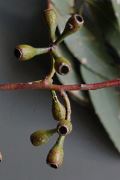 Grey Box (E. microcarpa) Smooth upper branches. Tree often Y-shaped. Common.
Grey Box (E. microcarpa) Smooth upper branches. Tree often Y-shaped. Common.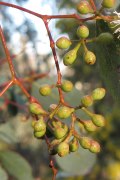 Red Box (E. polyanthemos) Leaves are often bluish, and almost as wide as long. Widespread and very common.
Red Box (E. polyanthemos) Leaves are often bluish, and almost as wide as long. Widespread and very common.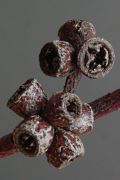 Long-leaf Box (E. goniocalyx) Branching spreading tree. Widespread and very common
Long-leaf Box (E. goniocalyx) Branching spreading tree. Widespread and very common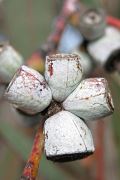 Mealy Bundy (E. nortonii) Like Long-leaf Box but buds, fruit powdered white.
Mealy Bundy (E. nortonii) Like Long-leaf Box but buds, fruit powdered white.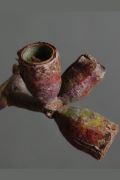 White Box ((E. albens) Large tree. Similar to grey box but buds and fruit are larger, and powdered white.
White Box ((E. albens) Large tree. Similar to grey box but buds and fruit are larger, and powdered white. 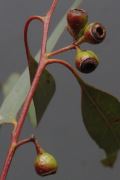 Yellow Box (E. melliodora) Bark variable. The leaves are small. Widespread. Prefers deeper soils e.g. creek flats.
Yellow Box (E. melliodora) Bark variable. The leaves are small. Widespread. Prefers deeper soils e.g. creek flats. 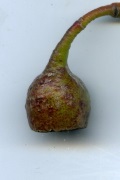 Red Ironbark (E. tricarpa) Tree with hard, rugged dark-coloured bark. Scattered.
Red Ironbark (E. tricarpa) Tree with hard, rugged dark-coloured bark. Scattered.Stringybarks (bark with long stringy fibres), Scentbark (bark rough almost stringy-barked) and Peppermints (box-like bark and very aromatic leaves)
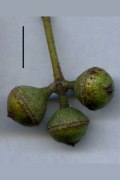 Red Stringybark (E. macrorhyncha) Buds with twisted beak. Leaves dull green. Very common.
Red Stringybark (E. macrorhyncha) Buds with twisted beak. Leaves dull green. Very common. 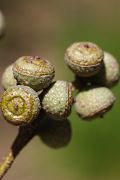 Small-leaved Brown Stringybark (E. aurifodina) Leaves glossy green. Uncommon. Scattered localities.
Small-leaved Brown Stringybark (E. aurifodina) Leaves glossy green. Uncommon. Scattered localities.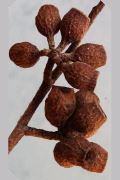 Messmate (E. obliqua) Leaves glossy green and asymmetric. Wetter forests to the south and Mt Alexander.
Messmate (E. obliqua) Leaves glossy green and asymmetric. Wetter forests to the south and Mt Alexander. 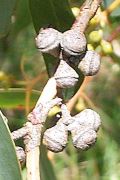 Silver-leaved Stringybark (E. cephalocarpa) Silvery leaves. Glenluce and Porcupine Ridge.
Silver-leaved Stringybark (E. cephalocarpa) Silvery leaves. Glenluce and Porcupine Ridge.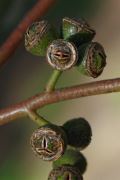 Castlemaine Scent-bark (E. conferta) Glenluce and Porcupine Ridge.
Castlemaine Scent-bark (E. conferta) Glenluce and Porcupine Ridge.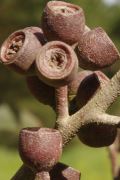 Broad-leaf Peppermint (E. dives) Straggling tree. Common south of Castlemaine e.g. Taradale.
Broad-leaf Peppermint (E. dives) Straggling tree. Common south of Castlemaine e.g. Taradale. 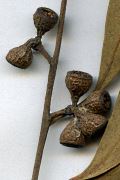 Narrow-leaf Peppermint (E. radiata) Erect tree. Common in wetter forests e.g. Trentham, Daylesford and Faraday.
Narrow-leaf Peppermint (E. radiata) Erect tree. Common in wetter forests e.g. Trentham, Daylesford and Faraday.Gums (most of trunk usually smooth-barked, may have a rough bark at the base)
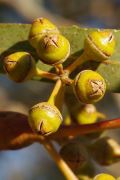 Red Gum (E. camaldulensis)
Red Gum (E. camaldulensis)Large spreading tree in open areas. Common along streams and swamps, and on granite.
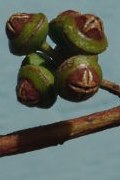 Blakely's Red Gum (E. blakelyi)
Blakely's Red Gum (E. blakelyi)Large tree. Resembles River Red Gum. Doubtful record.
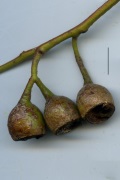 Yellow Gum (E. leucoxylon) Common on dry ridges and on forest flats. Local form grows to a tall erect tree.
Yellow Gum (E. leucoxylon) Common on dry ridges and on forest flats. Local form grows to a tall erect tree.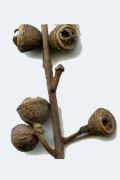 Candlebark (E. rubida)> Grows to a large tree. More common to the south of Castlemaine.
Candlebark (E. rubida)> Grows to a large tree. More common to the south of Castlemaine.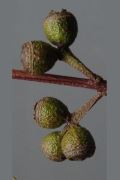 Manna Gum (E. viminalis) Streams, wetter forests, basalt, Mt Alexander. Bark on trunk often dense, dark.
Manna Gum (E. viminalis) Streams, wetter forests, basalt, Mt Alexander. Bark on trunk often dense, dark.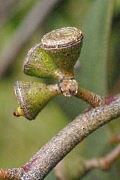 Swamp Gum (E. ovata)Leaves broad. Swampy places.
Swamp Gum (E. ovata)Leaves broad. Swampy places.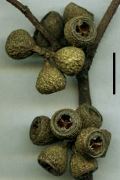 Snow Gum (E. pauciflora) Small tree. Rare locally. Elphinstone.
Snow Gum (E. pauciflora) Small tree. Rare locally. Elphinstone.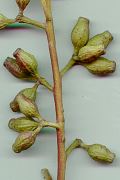 Sugar Gum (*E. cladocalyx) Large tree. Kalimna Point etc.
Sugar Gum (*E. cladocalyx) Large tree. Kalimna Point etc.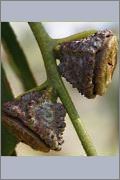 Blue Gum (*E. globulus) Large Tree. Chewton, Golden Point etc.
Blue Gum (*E. globulus) Large Tree. Chewton, Golden Point etc.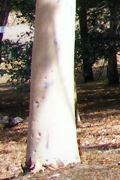 Lemon-scented Gum (*Corymbia citriodora)
Lemon-scented Gum (*Corymbia citriodora)White-trunked. Small tree. Rare locally. Newstead.